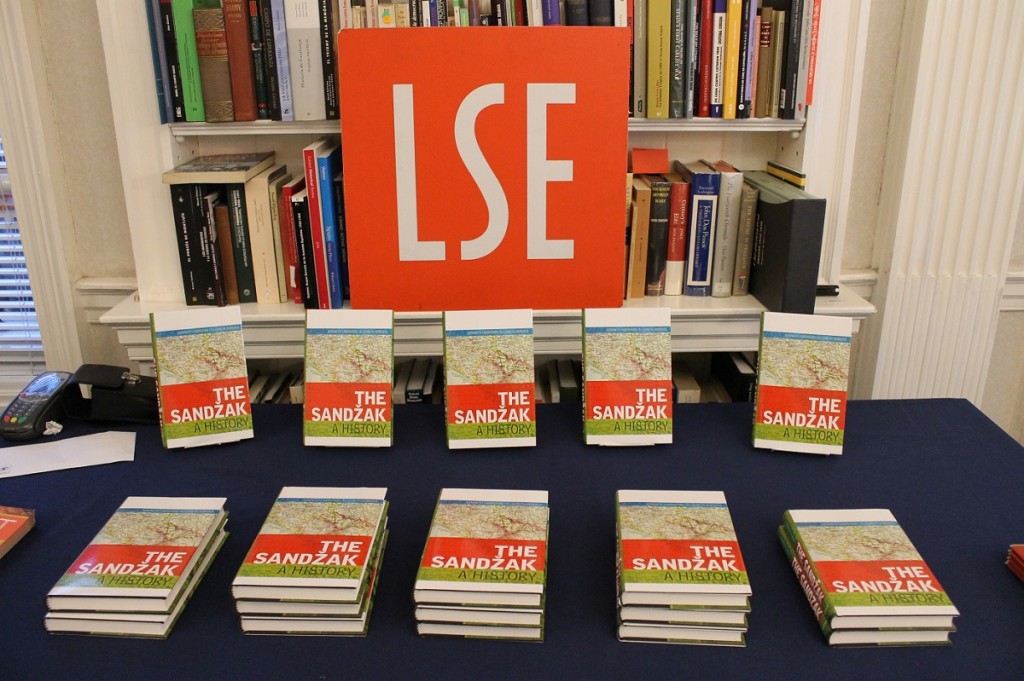 Dr Kenneth Morrison and Lady Elizabeth Roberts speak of their recent “The Sandžak: A History”, whose book launch was hosted by LSEE. The Sandžak (or Raška) is a historical region sitting across the borders of Montenegro and Serbia; today, Bosniaks represent the majority group of its mixed population. Morrison’s and Robert’s book is the first comprehensive historical account in the English language of this rather neglected, but very fascinating, region of the Balkans.
Dr Kenneth Morrison and Lady Elizabeth Roberts speak of their recent “The Sandžak: A History”, whose book launch was hosted by LSEE. The Sandžak (or Raška) is a historical region sitting across the borders of Montenegro and Serbia; today, Bosniaks represent the majority group of its mixed population. Morrison’s and Robert’s book is the first comprehensive historical account in the English language of this rather neglected, but very fascinating, region of the Balkans.
You are both recognized historians of South Eastern Europe. Of all places in the Balkans, why the Sandzak?
Our main motivation was simply to fill a gap in the existing literature. There has been, until now, no book in the English language that focused specifically on the Sandžak, though it is mentioned, albeit briefly, in almost every major work on 19th and 20th century Serbian/Montenegrin/Yugoslav/Balkan history. The area is something of a ‘terra incognita’ for many people, scholars and lay readers alike, in Western Europe, so our aim was to write something that would enable people to better understand this little known, but important part of the Balkans. The Sandžak has played a small but significant part in the history of the Western Balkans while remaining understudied and, outside the Western Balkans, almost completely unknown. The book was, therefore, written for an English- speaking audience that possesses a generally sound knowledge of Balkan history.
The Sandžak, as we explain in the introduction to the book, is a hitherto neglected region of the Western Balkans which, while it has never been a separate and independent political entity (apart from the ZAVNOS period between 1943-45, and only then largely in theory) has certain clearly discernible characteristics encompassing physical geography and historical-cultural factors, which in turn give the area its distinctive ethnic/social composition. In terms of its physical geography, the Sandžak is a trans-border region consisting largely of mountainous terrain and high plateau traversed by a number of intersecting river valleys which, crucially for the region’s history, have made possible the movement of people, armies, commercial goods and precious ores both north-south and east-west through the interior of the Balkan Peninsula. In terms of historical-cultural factors, the region has been variously incorporated in the course of its history into Roman provinces and was the heart of the early Serbian medieval kingdom (later Empire), before falling under Ottoman domination from the late 14th century until the Balkans Wars of 1912-13. The extensive period under Ottoman rule in combination with its strategically significant geographical location, in turn produced a socio-ethnic mix, which has meant that the Sandžak has, after Bosnia and Herzegovina, the largest concentration of Muslim Slavs in the Western Balkans. It is thus at once a transit zone and a cultural crossroads and this too gives the region a distinctive identity.
In the period between the 1878 Congress of Berlin and the end of Balkan Wars of 1912-1913, the Sandžak’s pivotal position in the centre of the Balkan Peninsula – between Serbia and Montenegro on the one hand and Bosnia and the road to Istanbul on the other – led to its acquiring a political and diplomatic significance it was to retain up until the outbreak of the First World War. It is interesting that in all the discussion so far of the causes of the First World War leading up to the 2014 Sarajevo centenary, the Sandžak’s part in the escalation of tension between Russia and Austria-Hungary has been largely overlooked. From the historian’s point of view, the Sandžak or more specifically the ‘Sanjak of Novibazar’, as the region was referred to in the second half of the 19th century, holds the particular attraction of being a once significant but now forgotten space, one which has been largely overlooked. As the esteemed British historian Norman Davies so succinctly said, there is a tendency to ‘stick to the well-worn ruts’ of history, so it’s important not to ignore such factors, given that they contributed to the wider political situation in the region at the time.
In terms of the contemporary situation, we do not believe that the Sandžak is destined to move away from its present status as part of Serbia and Montenegro, but we consider that the region’s present difficulties can be better understood and remedied in the light of an in-depth study of both its earlier history and more recent past.
In your opinion who should take interest in this book? Did you write it for historians, tourists, the general public..?
The book will probably have a relatively limited audience, but we hoped that scholars, students of European history and the wider public would be interested in reading it. Our aim was to make a contribution to the field of Balkan history which would complement the pre-existing literature.
There is a dispute in the public in Serbia whether that area should be called Sandžak (which reflects the name of a subdivision in the Ottoman Empire) or “Raška region”. How did you address this?
We were both fully aware of this issue and did our very best to treat this with sensitivity. We fully acknowledge that many citizens of both Serbia and Montenegro prefer to use the term ‘Raška’ or ‘Old Serbia’, and we also acknowledge that the term ‘Sandžak’ (or Sanjak of Novi Bazar) was not commonly used until the latter part of the 19th century. In the introduction to the book we go to significant lengths to explain this, while emphasizing that the history of the area should be understood in this context. At least one of the early chapters of the book focuses on the rise of the Nemanjic dynasty and the historical importance and significance of the old Serbian capital of Ras. We do not seek to underplay the importance of Raška as a central aspect of Serbian history. We consider the terms ‘Raška’ and ‘Sandžak’ to be equally legitimate, though we opted for the term ‘Sandžak’ for largely pragmatic reasons – in that Europeans are at least aware of the term. The vast majority of English-language history texts that deal with the so-called ‘Eastern Question’, for example, ascribe the term ‘Sandžak’ to the area, so it is already in the wider consciousness.
In your opinion, is there a contemporary “Sandžak question”?
That depends where you are and who you ask. More recent calls for autonomy have been the preserve of a relatively small group of people, and such sentiments are not shared by citizens across all Sandžak municipalities. So while, for example, there is some support for it in Novi Pazar and Tutin, there is considerably less support for it in, say, Nova Varoš or Priboj. It is almost impossible to envisage that contemporary Sandžak could become the focus of world attention, as was the case in the early 20th century.



